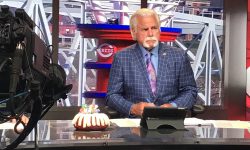The Mad Hungarian in Kansas City. via Royals Review
Very early one Sunday morning in the very late 1970s, I was behind the wheel of my truck with a couple of friends, parked outside of a country and western bar in Salina, Kansas, preparing for the drive home after a night of beer drinking and line dancing. Suddenly the doors to the bar flew open and a small cowboy burst out. He wasn’t your typical Kansas cowboy, he was Asian, quite possibly Japanese, and appeared to be about 5’6 and maybe 125 pounds. He gave his cowboy hat to a friend and proceeded to warm up with a series of kung fu moves. In those days, nobody called it martial arts. Everybody was kung fu fighting.
A short time later, the doors burst open again and a very large cowboy emerged. My ears perked up. This cowboy looked to be about 6’4’’ and solid, a big farm boy. I told my two friends, let’s stay and see where this goes. The Asian Cowboy continued to gyrate and make fighting noises. Oh-ho-ho-ho! Oh-ho-ho-ho! The big cowboy, thoroughly unimpressed, handed his hat to one of his friends, took a large step toward the smaller cowboy and unfurled a long, right hand, which connected with the smaller cowboy’s jaw. The kung fu cowboy’s body stiffened and fell backwards to the gravel parking lot, out cold. The big cowboy, satisfied with his handiwork, collected his hat and went back inside the bar, presumably for more beer and cotton-eyed Joe. The smaller cowboy’s friends gathered him up and with one supporting each side of his limp body, drug him away to a nearby car.
Now as you read that, you might think it’s just some story about two drunken cowboys fighting. To me, it was the perfect baseball analogy for the times. Heck, I’d seen dozens of bar fights, but nothing quite like this one. The smaller cowboy was, as my father might say, big hat, no cattle. In my mind he represented Al Hrabosky. The big cowboy represented Reggie Jackson. Cool, collected, and unimpressed with all of the noise going on around him. Someone who had the ability to change the game with one big swing.
Tired of playing second fiddle to the powerful New York Yankees and stung by public criticism from Manager Whitey Herzog on their inability to sign a free agent closer, in December of 1977 the Royals made a bold move. They traded their closer, Mark “Country” Littell and catcher Buck Martinez, to St. Louis for the Cardinals closer, Al Hrabosky. In those days, no one used the term closer. They were called firemen. Often, they were expected to pitch multiple innings to secure the win. The league was dominated by outstanding firemen like Mike Marshall, Tug McGraw, Goose Gossage, Rollie Fingers, John Hiller, and Sparky Lyle.
When the trade was first announced, my initial reaction was: We’re going to win the World Series! As you know, they didn’t. The St. Louis baseball team has always been a step or two ahead of their younger Missouri brother, or so it often seems. I mean why would they trade their closer for a 24-year-old power pitcher who had only appeared in 123 games and a 28-year-old catcher with a career .222 batting average?
Hrabosky himself was still only 27 but heading into his ninth year in the league, had a lot of mileage on his arm. He’d had an outstanding season in 1975 - a 13-3 record and a 1.66 ERA over 97 innings of work that resulted in 22 saves. The 22 saves led the league, and he was named National League Fireman of the Year. Remember, this was an era when starting pitchers were expected to finish their work. The Cardinals staff threw 33 complete games that season. It was a different time.
No, I think what the Cardinals had seen was that Hrabosky was slowly losing his mojo. In 1976, his ERA jumped to 3.30 and in 1977, it ballooned to 4.38. His hits allowed, runs allowed, and walks all rose while his strikeout numbers declined. It appeared that Royals General Manager Joe Burke got snookered.
Al Hrabosky was a fascinating player. Hrabosky was the epitome of 1970s macho. Longish hair. The Fu Manchu mustache. The intense stare. Prior to facing a batter, he’d retreat behind the mound, back to the plate and go through a ten-second psych-up routine. He’d slam the ball into his glove, charge to the mound, get the sign, which was almost always fastball, and go quickly into his motion.
Early on, hitters were distracted by the psych-out routine, his herky-jerky motion, and the roaring St. Louis crowds. Eventually, the fastball lost a few MPH and hitters quickly caught up. I don’t recall announcers ever hearing much about Hrabosky’s other pitches, if he had a curve or even a changeup. I suspect that as the fastball lost some velocity, it was mistaken for a changeup occasionally.
Hrabosky, a two-sport star in high school, had originally been drafted by the Minnesota Twins in the 11th round of the June 1967 draft, but did not sign. Instead, he went to Fullerton (CA.) College, and the Cardinals selected him in the first round of the 1969 January draft. He didn’t spend much time in the minors, pitching in fewer than 50 games before making his debut with St. Louis on June 16 of 1970. He bounced between the big club and the minors for the next three seasons before finally sticking with the Cardinals in 1974. He was a revelation that summer, going 8-1 with a 2.95 ERA over 88 innings of work. Then came his seminal 1975 season and the legend of the Mad Hungarian was born.
His introduction to the nation came on May 9, 1977, when the Cardinals hosted the Big Red Machine of Cincinnati on Monday Night Baseball. In those pre-cable days, games were only televised on Saturday afternoons, until ABC brought out Monday Night Baseball, the weak sister of the highly popular Monday Night Football. With the score tied at five in the ninth, Hrabosky gave up a single to Ken Griffey Sr., walked Joe Morgan, and gave up an infield single to Dan Driessen to load the bases.
He gathered himself and struck out George Foster, Johnny Bench, and Bob Bailey in succession while the Busch Stadium crowd roared. Hrabosky barely made it through the tenth. With two outs, Ray Knight singled. The next batter, Griffey, laced a double into the right-field gap, which looked like it might score Knight. The Cardinals made a nice relay and the throw from second baseman Don Kessinger to catcher Ted Simmons was on the money to nail Knight and end the inning. Simmons led off the bottom of the tenth and cranked a walk-off home run to right field to give Hrabosky the unlikely win. I know what you’re thinking. Kessinger played for the Cardinals? Yes, 204 games in 1976 and 1977. Hard to imagine him as anything but a Chicago Cub.
Hrabosky, on his website: www.alhrabosky.net, explains how he got the nickname “The Mad Hungarian”.
“I had been going back and forth to the minor leagues and suddenly in 1974, I was the Cardinals closer. My mind was wandering, and I had no concentration, so I needed to do something to stay in the big leagues. I developed a self-psyche routine of going behind the mound and mentally visualizing myself throwing strikes”.
It worked. Cardinal fans went crazy for it.
The Royals were going through problems of their own, having lost two close playoff series to the Yankees in 1976 and 1977. Whitey Herzog openly campaigned for the team to sign Goose Gossage, to no avail. The Cardinals made Hrabosky available after he clashed with rookie manager Vern Rapp in 1977. Rapp ordered the Cardinals to be clean-cut and wear short hair. “Relief pitching is 75% mental,” Hrabosky fumed. “How am I going to scare the hell out of hitters with my new image? How am I going to convince them I’m a dangerous madman if I look like a golf pro?” You got to love a guy like that.
The trade for Hrabosky was supposed to give Herzog the dominant closer he so desired. Hrabosky wasn’t terrible, he just wasn’t great. He appeared in 58 games in 1978 and recorded 20 saves. He only pitched 75 innings and his ERA was a respectable 2.88.
During the 1978 playoff series, Herzog used Hrabosky primarily as his eighth inning guy. He pitched one-third of an inning in Game One, giving up one hit, a home run to Reggie. He pitched the ninth inning of the Game Two Royals victory and mopped up the eighth inning of Game Three, after Doug Bird surrendered Thurman Munson’s titanic last home run in Yankee Stadium. He didn’t appear in the decisive Game Four as Dennis Leonard went the distance. It was Hrabosky’s only post-season appearance.
In 1979 he appeared in 58 games again, but only threw 65 innings. His ERA jumped to 3.74 and his save total dropped to 11, which still led the team. The Royals staff threw 53 complete games in 1978 and 42 complete games in 1979. As I said, it was a very different time. In July of 1979, another young relief pitcher named Dan Quisenberry, arrived in Kansas City and started to take innings away from Hrabosky.
The Royals missed the playoffs in 1979 and in November of that year, the Royals granted Hrabosky free agency. He signed a five-year, $3.2 million dollar deal with the Atlanta Braves. Hrabosky pitched for the Braves for the next three seasons, recording seven saves in 131 innings of work before being released. He signed a deal with the Chicago White Sox but never appeared in a game for them. He retired at the age of 32.
I remember seeing Hrabosky pitch in 1978. I don’t recall who the Royals were playing but the team was rolling towards the playoffs and holding a slim late-inning lead, brought Hrabosky in to protect it. The large crowd went wild when he took the mound and reached a crescendo as he went through his routine. The luster quickly wore off after a couple of hits and a walk. I remember thinking two things: Is that it? The second was, we're not winning the World Series this year. Big hat, no cattle.
You have to give Hrabosky credit though. He fashioned a 13-year career, made some money, and brought some life to an otherwise staid game. He was really one of the first players to create a “brand”, which seems more important to athletes today than the actual game. The nickname, The Mad Hungarian, is one of the most recognizable nicknames in modern baseball history. After retiring, Hrabosky embarked on a long and successful career as a color commentator for the Cardinals, where he has become a St. Louis institution. He was inducted into the Missouri Sports Hall of Fame in 2003 and is active in many charities in the St. Louis area, where he and his wife, June, reside.




